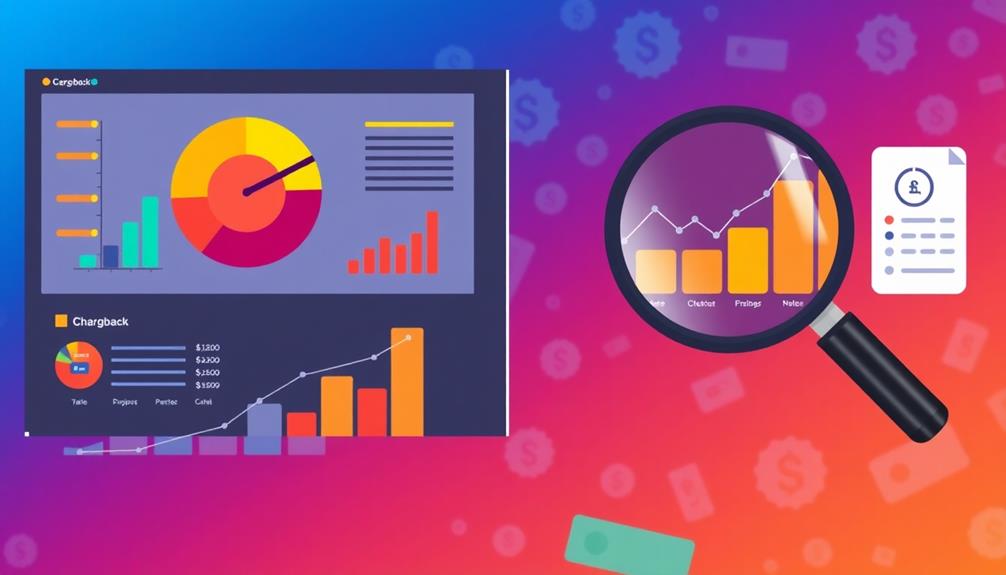You can harness chargeback analytics to proactively prevent disputes and protect your bottom line. By systematically collecting and analyzing chargeback data, you can uncover the root causes of disputes and develop effective strategies to reduce them. Utilize different types of analytics—descriptive, predictive, and prescriptive—to make informed decisions. Additionally, continuous monitoring helps you identify high-risk sources and operational inefficiencies. Ultimately, enhancing customer experience and streamlining dispute resolution processes can greatly minimize chargeback risks. If you want to know how to implement these strategies effectively, there's plenty more to explore.
Key Takeaways
- Chargeback analytics involves systematic data collection and analysis to identify root causes and develop strategies to prevent future disputes.
- Descriptive, predictive, and prescriptive analytics are utilized to understand trends, forecast chargeback rates, and offer actionable recommendations.
- Analyzing customer dissatisfaction patterns and operational inefficiencies can lead to improved service and reduced chargebacks.
- Continuous monitoring of high-risk traffic sources and repeat offenders enhances dispute management and minimizes losses.
- Effective communication and clear billing practices help prevent misunderstandings that lead to chargebacks, improving overall customer experience.
What Is Chargeback Analytics?
Understanding chargeback analytics is vital for any business that processes transactions online. It involves systematically collecting and analyzing chargeback data to pinpoint the root causes of chargebacks. By doing this, you can develop effective strategies to prevent chargebacks in the future.
Additionally, having a solid grasp of common financial terms can enhance your comprehension of the financial aspects related to chargebacks and disputes.
Chargeback analytics examines operational inefficiencies and customer behavior trends, helping to enhance the overall customer experience while reducing complaints. The process employs various analytical types—descriptive, predictive, and prescriptive analytics—to inform your strategic business decisions, enabling you to mitigate chargebacks effectively.
Data collection for chargeback analytics includes important transaction details, customer information, payment processing data, and specific chargeback metrics, such as reason codes and outcomes. By continuously analyzing this chargeback data, you can identify high-risk traffic sources and monitor repeat offenders, which is essential for improving your dispute management processes.
Ultimately, understanding chargeback trends through analytics allows you to take proactive measures, ensuring that your business remains resilient against potential disputes and financial losses. By leveraging this data, you position yourself to make informed decisions that can greatly reduce chargebacks.
Importance of Chargeback Analytics

Understanding the causes of chargebacks is essential for your business's success. By analyzing this data, you can enhance your financial health and implement strategies that reduce losses.
For instance, establishing a solid retirement savings plan can help you allocate resources more effectively.
With effective chargeback analytics, you'll not only tackle current issues but also prevent future disputes.
Understanding Chargeback Causes
Identifying the root causes of chargebacks is essential for any merchant looking to protect their revenue and improve customer satisfaction. Chargeback analytics can help you uncover these causes, allowing you to implement effective fraud prevention strategies.
By utilizing advanced fraud detection techniques, such as predictive analytics, you can proactively address potential issues before they escalate into disputes.
Here are some common root causes of disputes you should consider:
- Fraudulent transactions: Understanding the types of fraud impacting your business can help you develop targeted prevention measures.
- Customer dissatisfaction: Identifying patterns in complaints can lead to improved service and product offerings.
- Operational inefficiencies: Analyzing your processes can reveal areas that need improvement to reduce confusion for customers.
- Miscommunication: Clear communication about your policies, products, and services can minimize misunderstandings.
- Billing errors: Regularly reviewing your billing practices can prevent unintentional charges that lead to disputes.
Enhancing Merchant Financial Health
Chargeback analytics is an vital tool for enhancing merchant financial health, as it provides clear insights into the causes and patterns behind chargebacks. By understanding the nature and sources of chargebacks, you can implement effective chargeback management strategies that greatly mitigate losses.
Additionally, being aware of small mistakes, big impact can further improve your decision-making processes. Utilizing thorough dashboards for chargeback data allows you to customize your analysis, pinpointing specific prevention tools that can reduce fraud and improve your bottom line.
With the global chargeback volume projected to reach $165 billion by 2024, the urgency to adopt effective chargeback analytics has never been greater. A well-implemented strategy not only reduces chargeback incidents but also addresses common customer complaints, enhancing their overall experience.
This, in turn, fosters customer loyalty and retention, which are essential for your financial stability. Ultimately, effective chargeback analytics allows you to take proactive measures against chargebacks, ensuring your business remains profitable and resilient.
Types of Chargeback Analytics

In today's competitive landscape, leveraging different types of chargeback analytics can greatly enhance your business strategy. By understanding how each type works, you can effectively manage chargebacks and minimize losses.
High-quality analytics, such as importance of content quality, can also provide you with deeper insights into customer behavior and transaction patterns.
- Descriptive Analytics: This analyzes historical chargeback data to uncover trends and understand the reasons behind past disputes, helping you address recurring issues.
- Predictive Analytics: Utilizing data science techniques, this forecasts future chargeback rates, allowing you to anticipate and mitigate potential disputes before they occur.
- Prescriptive Analytics: This offers actionable recommendations, guiding you in developing strategies to minimize chargebacks by focusing on operational inefficiencies and customer dissatisfaction.
- Integrated Insights: Chargeback analytics combines findings from various data types, including transaction details and customer behavior, to inform your overall business strategies.
- Improved Customer Experience: By utilizing these analytics collectively, you can enhance customer satisfaction while effectively managing chargebacks.
Collecting Data for Analysis

To kick off effective chargeback analytics, you'll need to gather a variety of data points that form the backbone of your analysis. Start with fundamental transaction data, including purchase dates, transaction IDs, and amounts. These details are essential for identifying patterns in disputes and can greatly impact your chargeback rates.
Additionally, monitoring your credit card statements regularly can help you catch fraud early, which is imperative for reducing chargebacks.
Next, collect customer information like demographics and purchasing behavior. This data helps you recognize trends and potential issues that may lead to chargebacks.
Additionally, payment processing data is important for uncovering inefficiencies in your transaction flow that contribute to disputes.
Don't forget to include chargeback data, such as reason codes and outcomes. This information provides insights into the types of disputes you're facing and enables you to devise targeted prevention strategies.
Aggregating data from various systems can further enhance your chargeback management strategies. This holistic approach allows you to uncover hidden insights that can improve your overall performance.
Analyzing Chargeback Data

When you analyze chargeback data, focus on traffic sources to pinpoint which channels lead to higher chargeback rates.
Additionally, understanding the IRA inheritance rules can provide insights into managing financial disputes related to retirement accounts.
You should also keep an eye on chargeback lag time to uncover any operational issues or customer dissatisfaction.
Traffic Source Insights
Understanding traffic source insights is crucial for merchants looking to minimize chargebacks. By conducting traffic source analysis, you can uncover critical information about how different channels impact your chargeback rates. This allows you to identify which sources lead to higher disputes and adjust your strategies accordingly.
For instance, monitoring the impact of Bitcoin IRA tax hacks on customer purchasing behavior can provide deeper insights into chargeback trends.
Here are some key points to reflect on:
- Certain channels, like social media or specific ad campaigns, may drive customers who are more likely to dispute transactions.
- Monitoring chargeback rates helps you distinguish between genuine complaints and friendly fraud.
- Insights from traffic source analysis can inform your marketing strategies, focusing on channels that yield high-quality traffic.
- Continuous evaluation of chargeback rates reveals valuable customer behavior patterns, enhancing your decision-making.
- Mitigating risk from problematic traffic sources can lead to improved overall performance and customer satisfaction.
Chargeback Lag Analysis
Analyzing chargeback lag time reveals important insights into customer behavior and the dynamics of disputes. This metric measures the duration between the transaction date and when a chargeback is initiated. By examining chargeback lag time, you can identify patterns that indicate how and when customers decide to dispute transactions.
For instance, a shorter lag time often suggests impulsive decisions, which might stem from customer dissatisfaction or confusion about a purchase. Understanding the impact on financial performance can further guide your strategies in addressing these issues.
Understanding these delays enables you to develop targeted strategies that address customer concerns more swiftly. If you notice a pattern of prolonged lag times on specific products or payment methods, you can adjust your approach to minimize disputes.
For example, enhancing product descriptions or clarifying charges can alleviate confusion, potentially reducing fraud.
Continuously monitoring chargeback lag times not only helps you manage disputes more effectively but can also lead to improved win rates in chargeback cases. By staying proactive and responsive to the insights gained from analyzing lag time, you can enhance your overall dispute management processes and foster better customer relationships.
Issuer Outcome Examination
Examining chargeback outcomes based on specific issuing banks provides valuable insights that can enhance your dispute strategies. By analyzing issuer outcomes, you can identify trends that inform how to tackle chargebacks effectively.
Understanding which banks are more likely to side with customers allows you to implement targeted fraud prevention measures. Additionally, by evaluating the risks and rewards associated with various payment methods, you can better prepare for potential chargebacks and guarantee a more secure transaction environment. This is particularly essential when considering protecting your savings from fraudulent activities.
Here are some key aspects to focus on:
- Identifying patterns in issuer behavior to anticipate chargeback risks.
- Recognizing discrepancies in chargeback resolutions for better strategy adjustments.
- Improving transaction processes and customer communication to minimize disputes.
- Spotting issuers with high rates of friendly fraud to refine your prevention tactics.
- Optimizing dispute responses based on issuer-specific data for higher success rates.
Benefits of Data-Driven Strategies

Data-driven strategies offer significant advantages for businesses dealing with chargebacks. By analyzing chargeback data, you can uncover patterns that reveal the underlying causes of disputes. This insight allows you to implement targeted prevention measures, ultimately reducing chargeback rates. In fact, companies leveraging effective analytics often see up to a 30% decrease in chargebacks.
Utilizing predictive analytics also empowers you to forecast potential chargeback trends. With this foresight, you can make proactive adjustments in your operations and customer service practices, which helps mitigate risks associated with chargebacks and fraud.
Additionally, data analysis enhances your understanding of customer behavior, enabling you to create tailored marketing strategies that improve customer satisfaction and retention. Happier customers mean fewer chargebacks.
Moreover, companies that adopt thorough chargeback analytics report improved decision-making processes, contributing to long-term financial health. By reducing operational costs tied to managing disputes, you can allocate resources more efficiently.
Fraud Detection and Prevention

Fraud detection is essential for any eCommerce business aiming to protect its revenue and reputation.
With the US online retail industry facing approximately $22.8 billion in annual losses due to fraudulent returns, effective measures are vital.
Using data analytics, you can identify fraudulent transactions and implement prevention strategies to safeguard your business.
Here are some key tactics you can adopt:
- Monitor transaction patterns to identify anomalies.
- Flag suspicious activities, like multiple orders from a single IP address.
- Utilize algorithms to analyze unusual purchasing patterns.
- Implement real-time analytics tools for proactive detection.
- Educate your team on recognizing signs of fraud.
Improving Customer Experience

Enhancing customer experience is a natural progression from implementing effective fraud detection and prevention measures. By utilizing chargeback analytics, you can identify common complaints and operational inefficiencies that directly impact your customers. Understanding these pain points allows you to tailor your services and communication, which helps reduce the likelihood of disputes and boosts customer satisfaction.
Adopting data-driven strategies to prevent issues not only streamlines your dispute resolution processes but also guarantees you address customer concerns quickly and efficiently. When customers see their issues being handled promptly, their overall experience improves markedly.
Regularly monitoring chargeback trends also provides valuable insights into areas of customer dissatisfaction. This enables you to make proactive adjustments to your policies, enhancing interactions and further reducing chargeback occurrences.
Moreover, optimizing your return and refund policies based on analytics fosters a transparent and customer-friendly approach. This not only builds trust but also encourages customer loyalty.
Ultimately, by focusing on these data-driven strategies, you'll create a more positive customer experience that keeps your customers coming back while minimizing disputes.
Chargeback Management Solutions

Chargeback management solutions frequently streamline the dispute resolution process, making it easier for you to handle chargebacks efficiently.
These tools not only reduce the time spent on manual tasks but also enhance your overall operational efficiency. By integrating automated dispute submission capabilities, you can respond to chargebacks quickly, which often leads to increased win rates.
Here are some key benefits of using chargeback management solutions:
- Automated Responses: Quickly address chargebacks with minimal effort.
- Real-Time Reporting: Monitor trends and adjustments in real-time.
- Data-Driven Insights: Glean insights from analytics to make informed decisions.
- User-Friendly Interfaces: Navigate the tools easily, ensuring effective dispute management.
- Targeted Prevention Strategies: Identify common chargeback causes and mitigate future risks.
With the right chargeback management solution, you can leverage data to help you manage disputes more effectively, turning challenges into opportunities for improvement.
Embracing such tools means you're not just reacting to chargebacks but proactively preventing them, enhancing your business's resilience in the face of disputes.
Recommended Resources for Further Learning

To deepen your understanding of chargebacks and improve your management strategies, it's essential to tap into a variety of resources designed for learning.
Start with "A Definitive Guide to Understanding Chargebacks," which lays the groundwork by defining chargebacks, exploring their causes, and detailing their impacts on businesses. This foundational knowledge will help you grasp the complexities involved.
Next, consider "Chargeback Management: 3 Keys to Managing Chargebacks Effectively." This resource provides strategic insights that can enhance your handling processes and ultimately reduce financial losses.
Additionally, "7 Attributes of a Highly Effective Chargeback System" highlights essential features that can greatly improve your chargeback management efforts.
If you're looking to streamline your accounting processes, "3 Ways to Simplify Your Chargeback Accounting" offers practical operational efficiencies that can optimize your resource management.
Finally, "Evaluating Chargeback Management Solutions: A Helpful Guide" will assist you in making informed decisions regarding the right tools and services to adopt.
Each of these resources provides valuable data to determine the best course of action for effectively managing chargebacks in your business.
Frequently Asked Questions
What Is Chargeback Analysis?
Chargeback analysis is where you examine chargeback data to spot patterns and trends. By understanding root causes, you can improve transaction processes, reduce disputes, and ultimately protect your business from financial losses.
Is There a Way to Prevent Chargebacks?
Yes, you can prevent chargebacks by implementing clear return policies, monitoring transaction patterns, and using predictive analytics. Addressing customer concerns proactively and optimizing your processes helps reduce disputes before they escalate into chargebacks.
What Are the Statistics for Chargebacks?
You'll find that global chargeback volume is expected to hit $165 billion in 2024, with 60% of merchants managing them manually. On average, e-commerce faces chargeback rates of 1-2%, especially higher in digital goods and travel.
What Are the Three Sources of Chargebacks?
When it rains, it pours. The three sources of chargebacks you'll encounter are fraud, customer disputes, and merchant errors. Recognizing these can help you tackle issues before they escalate into costly chargebacks.
Conclusion
In the ever-evolving world of e-commerce, chargeback analytics is your shield against disputes, empowering you to protect your business and enhance customer trust. By harnessing data effectively, you can not only detect fraud but also improve customer experiences, turning potential conflicts into opportunities for growth. Remember, each chargeback is a lesson; learn from them, and let your analytics guide you toward a smoother, more secure future. Your proactive steps today can create waves of success tomorrow.










